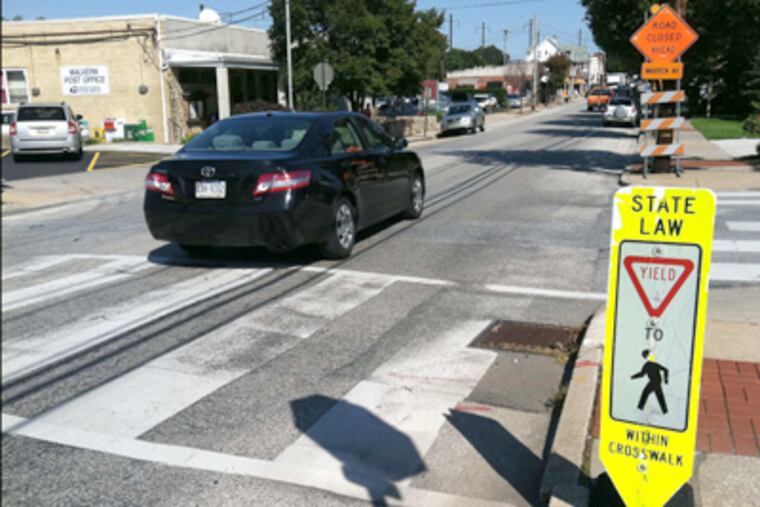Pedestrian yield signs aimed at voluntary compliance
They were like bright-yellow dandelions. First one, then two. Then, everywhere. Ten years ago, the Commonwealth of Pennsylvania bought 500 yield-to-pedestrian markers to be placed at crosswalks here and there.

They were like bright-yellow dandelions. First one, then two. Then, everywhere.
Ten years ago, the Commonwealth of Pennsylvania bought 500 yield-to-pedestrian markers to be placed at crosswalks here and there.
Now, there are 7,000 markers, with the number growing all the time.
"State law," the portable, three-foot-high markers announce in black letters. They depict a triangular yield sign and show a stick figure of a man on foot.
Could these markers - usually set down on the centerline of the road - really have the force of law, like a red light or a stop sign?
Not by themselves.
The Motor Vehicle Code has always required drivers to give way to pedestrians at painted crosswalks, whether on the corner or in midblock.
The signs are "just a reminder" of what was already mandated but often disregarded, said Stephen Dunlop, the bicycle-and-pedestrian program coordinator in the regional office of the Pennsylvania Department of Transportation in Valley Forge.
"We're trying not to get someone hit in the crosswalk; that's the whole idea," he said.
Drivers may be taking more notice of the signs because in some areas the markers may be reaching "the saturation point," he said.
The portable markers have shown up along shopping strips in urban Manayunk and suburban Bryn Mawr, on York Road in Hatboro, at a golf-cart crossing in Wayne, on the campus of Philadelphia University, at Wilson Farm Park in Tredyffrin.
In the five-county Philadelphia region alone, PennDot has provided 1,215 markers - free - to communities that have asked for them.
"After hours, when there are not [pedestrians] on the road, they're supposed to take them off and not leave them out," Dunlop said. "We generally suggest that. But we are not enforcement."
Many signs are so beaten and battered they look as though they've been run over by trucks, which, in many cases, they have been, Dunlop said.
The markers are just wide enough to sit on the double-yellow line down the middle of a road. They are intended to be placed far enough from intersections to give trucks room to make turns.
But - bam! - down they often go.
Designed to federal highway standards, the markers are employed to some extent in most states as a way to cut down pedestrian fatalities.
In Pennsylvania, 134 pedestrians were killed in 2009, the last year for which statistics were available.
In New Jersey, with a smaller population, there were 157 pedestrian deaths.
Like Pennsylvania, New Jersey for decades had a law requiring motorists to yield to pedestrians at crosswalks. But last year the state changed that law to force drivers to make a complete stop when pedestrians are waiting at crossings.
The state has gotten rid of yield-to-pedestrian markers and is gradually replacing them with almost identical stop-for-pedestrian signs. At least a few hundred are on the roads, the state transportation department said.
"I think motorists did not understand what the meaning of yield was; this brings clarity," said Gary Poedubicky, acting director of the New Jersey Division of Highway Traffic Safety.
"We need to change the culture and improve safety for basically all our highway users," he said. "Until we get into the habit of stopping for pedestrians in the crosswalk, there are going to continue to be problems."
Markers need not be bought by a state or a municipality. Anyone - for a cost of a couple hundred dollars over the Internet - can buy a yield-to-pedestrian or stop-for-pedestrian sign.
In front of a Genuardi's supermarket in King of Prussia, there's often a marker that says it's "state law" to stop for pedestrians in crosswalks.
Of course, that's not Pennsylvania law. But it may slow people down. And it's on private property.
In Hatboro, where town officials have acquired four yield signs through PennDot, Police Chief James Gardner said his officers had issued a handful of citations for failure to yield to pedestrians.
He noted that though the fine may be only $25, it gets jacked up to $110 with fees and court costs. And the real penalty could be the two points added to offenders' driving records.
(Penalties in New Jersey also included two points - and a $200 fine, plus court costs.)
Gardner said pedestrians, too, can be fined. They are required to stand back rather than suddenly march into the path of drivers.
"They think they can just walk out into the street and traffic will magically stop," he said.